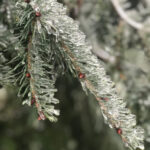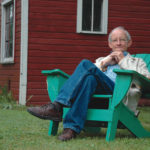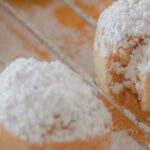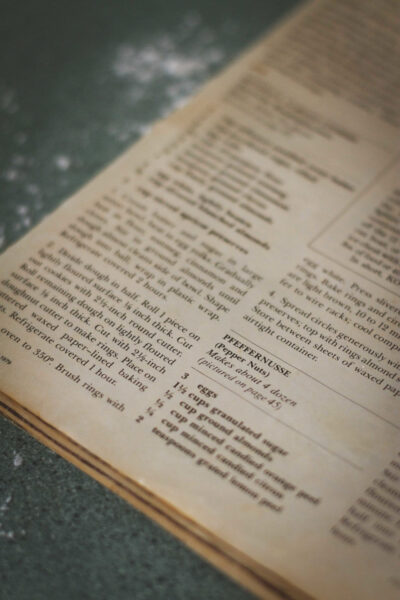Our January 15th concert, New Beginnings, will be online only. There will no longer be an in-person audience.
Our Christmas Tree Adventure – Part 1
We love the holidays.
They are a time for beautiful festive music, twinkling lights, memorable moments, and wonderful times with our families. We sent two new members of the SSO family out for an unforgettable afternoon filled with power tools and holiday cheer.
*No musicians were harmed in the making of this video
Thomas Schudel’s Winter Suite
Composer Thomas Schudel was born on September 8, 1937, in Defiance, Ohio. A composer, bassoonist and teacher, he completed his BSc in Music Education and Master’s in Theory and Composition at Ohio State University and received his Doctor of Musical Arts degree at the University of Michigan in 1971.
He joined the faculty at the University of Saskatchewan Regina Campus in 1964 and became Head of the Music Department in 1975, a post he held until 1978. Counterpoint, analysis, and woodwinds were among the classes he taught during his tenure.
Schudel held the position of principal bassoon with the Regina Symphony Orchestra from 1964 -1967 and then again from 1968 to 1970.
In 1972, Schudel’s Symphony No. 1 garnered first prize in the City of Trieste International Competition for Orchestral Compositions. His works have been performed across Canada and internationally; many are published in Canada and the USA. Thanks to commissions from provincial groups such as the Saskatchewan Music Festival Association (SMFA), his music has been showcased throughout the province. The SMFA included his works in their 2004-05 syllabus, thus reaching children in many communities. Other works have been commissioned by the Saskatchewan Music Educators Association and the Saskatchewan Choral Federation, as well as by the Canada Council and the CBC.
During our concert A Winter’s Journey our wind quintet performs Schudel’s A Winter Suite.
Poet Ted Kooser
Our concert opens with spoken-word artist Carol Greyeyes reading a work written by poet Ted Kooser.
Ted Kooser was the Poet Laureate Consultant in Poetry for the Library of Congress from 2004-2006. He is also Presidential Professor Emeritus at The University of Nebraska, where he taught the writing of poetry. For most of his career, he was a life insurance salesman and would spend about an hour and a half writing poetry before work. By the time he retired from his insurance career, he had published 7 books of poetry. Kooser received the 2005 Pulitzer Prize for Poetry for his book Delights & Shadows.
The work being read at our concert is called December 21, Clear and five degrees. It is from a collection of postcards written by Kooser to Jim Harrison. The entire collection is entitled Winter Morning Walks and there are 100 postcards in total. In the late 1990s, Kooser developed cancer and gave up both his insurance job and writing. When he began to write again, it was to send daily poems on postcards he sent in correspondence with his friend and fellow writer Jim Harrison. In poems both playful and serious, Kooser avoids talking directly about his illness. Rather, he refers to disease and the possibility of dying in metaphors focusing on the countryside around his Nebraska home, where he took long walks for inspiration.
Kooser’s walks have also inspired others. Grammy award-winning composer, Maria Schneider, used Kooser’s poetry to create a song cycle called Winter Morning Walks. It was written for and performed by the Australian Chamber Orchestra, Dawn Upshaw, Jay Anderson (bass), Frank Kimbrough (piano) & Scott Robinson (alto clarinet & bass clarinet).
You can hear a sample on this clip from PBS where the interview Dawn Upshaw and Maria Scneider about the creation of the beautiful song cycle.
Pfeffernusse with Margaret!
This post was created for our 2021 Holiday Pops. The recipe is so good, we couldn’t help but share it again!
Christmas is all about the music…but its really all about the baking!
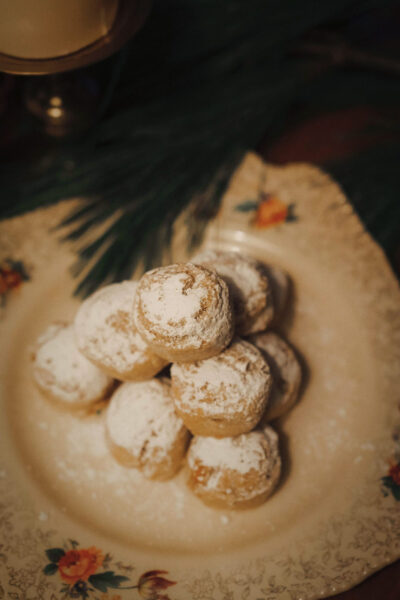 Our Holiday Pops concert this year is special – its the first time we’ll have the full orchestra for our annual festive show in two years…so it feels like we’ve got everyone home for the holidays. It’s going to be a night filled with festive joy.
Our Holiday Pops concert this year is special – its the first time we’ll have the full orchestra for our annual festive show in two years…so it feels like we’ve got everyone home for the holidays. It’s going to be a night filled with festive joy.
Last year we decided we would invite ourselves into the kitchen’s of our Principal Bassoonist and Director of Administration for some cookies and toffee, and this year we wanted to try something traditional. Margaret Wilson, the SSO’s Principal Clarinetist, had a family tradition of making pfeffernusse for Christmas and it seemed perfectly fitting for a Holiday Pops that feels like a family homecoming.
Margaret is no stranger to our annual Holiday Pops as she’s been our Principal Clarinetist for 45 seasons! To hear how excited she is for these new arrangements by Maria Fuller means that the concert is a festive treat.
Pfeffernusse is a traditional German cookie that is just the right blend of savory and a touch of sweet. They date all the way back to 1753 and have been part of Yuletide celebrations in Germany since 1850!
There’s even wonderful stories about the composer Felix Mendelssohn traveling a good distance just to get Pfeffernusse, writing: “I can’t conduct the Düsseldorf Music Festival because I have to rest and move to Soden, I’m going to Offenbach with Ms. Bernus to buy Pfeffernüsse.”
Let’s get started!
 3 eggs
3 eggs- 1 1/2 cups sugar
- 1/2 cup ground almonds
- 3/4 cup minced candied peel
- 2 tsp. grated lemon peel
- 3 cups (approximately – probably less) all-purpose flour
- 1 tsp. cinnamon
- 1/4 tsp. ginger
- 1/2 tsp. ground pepper
- 1/8 tsp. ground cloves
- 1/4 cup rum or brandy
- powdered sugar
l. Beat eggs and sugar with electric mixer in large bowl until thick and lemon coloured. Stir in almonds, candied peel and grated lemon peel
2. Sift together approximately ll112 cups cups of flour with the cinnamon, ginger, pepper and cloves. Stir into egg mixture and keep adding more flour until dough almost cleans side of bowl.
3. Knead on lightly floured surface, adding as much flour as needed until smooth – about 1 minute.
4. Divide dough in half: shape each half into log 1 1/2 inches in diameter. Refrigerate wrapped in plastic wrap at least one hour.
5. Cut logs into 3/4 inch thick slices: round edges slightly. Place slices on greased or parchment lined baking sheets. Let stand at room temperature overnight.
6. Heat oven to 325 degrees. Turn cookies over. Bake until centres are firm to the touch and tops are golden – approximately 20 minutes.
7. Transfer to wire racks. Brush cookies generously with rum or brandy; sprinkle generously with powdered sugar. Cool completely. Texture and flavour improve if allowed to age in airtight container 1 to 2 weeks.
Margaret’s secret tip: Although the original recipe calls for the spices to be sifted into the 3 cups of flour, I have never been able to work in that much flour. That is why I put the spices into less flour to start and then work in as much flour as need – usually about 2 1/4 – 2 l/2 cups.
Time to get your baking hat on!
[youtube https://www.youtube.com/watch?v=fJrc2Yesn08]
A Message from Nutrien
In the spirit of the season, your friends and neighbours at Nutrien are delighted to share the gift of performance with you this evening.
As a supporter of the Saskatoon Symphony Orchestra, we appreciate the efforts of the diverse group of artists and organizers who helped make this special evening possible. It is a testament to what can be created by people who share a vision and commitment to a common goal.
While our growing company has an expanding reach, our purpose is to grow our world from the ground up – and that starts here at home.
Nutrien looks for opportunities to build our community and to celebrate the many gifts that come from being a part of it. Through music, art and recreation, we strive to bring people together in a shared desire to make Saskatoon a better place to work and live for all of us. We, too, believe in creating special moments with diverse groups across our community.
It is our sincere wish that you enjoy tonight’s performance and that we have helped get your holiday season started on the right note.

Toffee for Christmas – Watch Party Idea
This post was part of our holiday celebrations in 2020, but we wanted to bring this wonderful recipe back for you!
At the SSO offices, December means one thing…our Director of Administration is bringing Toffee to work.
Natal Laycock’s role at the SSO is an important one (not just because of the toffee!), and we all think she’s part super-human as she handles work, home, kids, even piano lessons! In her 6 years at the SSO, her toffee has become the stuff of legends – its not every day that someone has made toffee for you, so when it happens its a memorable moment.
We invaded Natal’s toffee making this year to steal her recipe for you to give a try as a pairing with our Candlelight Christmas concert!
Delicious – let’s get started!
 Here’s what you need – Ingredients:
Here’s what you need – Ingredients:
1 can condensed milk (Orignal, not low fat)
1 cup cane syrup (ie Roger’s Brand)
1/2 cup butter (scant)
2 cups golden or brown sugar
But you’ll also need…
Heavy bottom sauce pan (2.5L or larger)
Long handled wooden spoon
Candy thermometer (optional, but recommended)
cookie sheet
parchment paper (or extra butter)
Optional – up to you, but not in ours:
chopped nuts
Now let’s get to it!
 Step 1: Line the cookie sheet with parchment, or grease with butter and set aside. If using nuts, sprinkle on the sheet now.
Step 1: Line the cookie sheet with parchment, or grease with butter and set aside. If using nuts, sprinkle on the sheet now.
Step 2: Combine all ingredients into sauce pan, and set the burner to at least med-high.
Step 3: Stir continuously, scraping the bottom, so the sugar does not burn to the bottom of the pan. The mixture will begin to change color, and fleck with darker pieces.
Warning: boiling candy splatters, and it burns!
The mixture will need to boil until it reaches over 300*F (hard crack). This will take roughly 20 minutes, depending on your burners. Keep stirring and scraping! Stick the candy thermometer in after about 10 minutes, ensuring it stays below the surface, and off the bottom of the pan to get an accurate read.
 Step 4: Once the mixture has reached hard crack, remove from heat and pour over prepared cookie sheet.
Step 4: Once the mixture has reached hard crack, remove from heat and pour over prepared cookie sheet.
Optional step: ‘score’ the toffee when it is partially set. Leave the toffee out at room temperature. Drag a butter knife across the surface to create break or ‘score’ lines in roughly the size of the pieces you want to make. If the toffee sticks to the knife, or the lines fill back in, it’s still too hot.
Step 5: Set tray in fridge/freezer/snow bank until set and then break apart. If you’ve scored it, turn the toffee upside down so the score lines are facing down.
Step 6: Break it up! As you can see from the video, even a screwdriver works…
 Important: Store in a ziploc bag, or sealed container, and keep refrigerated.
Important: Store in a ziploc bag, or sealed container, and keep refrigerated.
It’s an incredibly tasty treat that is worth all that time standing over the heat! And once you’re done, it can be enjoyed with a number of classic holiday drinks…hot cocoa, milk, tea, coffee (Baileys optional!), and peppermint schnapps.
If you’ve never tried to make homemade toffee, this is your year. Let us know how it turned out!
Leroy Anderson’s Music is Christmas
Not many people do their best thinking during a heat wave. Then again, most people are not Leroy Anderson. The original idea for the light-hearted orchestral romp known as “Sleigh Ride” was born in the mind of the American composer during a heat wave in July of 1946.
Finished in February 1948, the instrumental piece would not receive its classic lyrics until 1950 (when lyricist Mitchell Parish added in the bits about riding in a sleigh and other fun wintertime activities). The orchestral version was first recorded in 1949 by Arthur Fiedler and the Boston Pops Orchestra. It quickly became one of the orchestra’s signature songs, and the 45 rpm version was originally issued on red vinyl in celebration of the Christmas season. So catchy was the main melody that other composers of the era tried to pass it off as their own. The main melody of “Sleigh Ride” was used without credit to Anderson in the 1949 western “Streets of Laredo”, scored by Victor Young. Sleigh Ride lyricist Mitchell Parish worked with Young around this time, which might explain how the latter got his not-so-bright idea to “sample” Anderson’s work. That very same year, The Andrews Sisters created the first ever recording of Parish’s vocal version, and the popularity of Sleigh Ride sped off like… well, like a Sleigh Ride!
Although the piece is often associated with Christmas, appearing on more Christmas compilation albums than one can even count, its lyrics leave out any mention of a holiday. Perhaps this is what lends a universal appeal to Sleigh Ride. The song is noted for the characteristic sounds of a horse clip-clopping its way down a country road, and the sound of a whip is featured in most versions to give the illusion of the horse being spurred into motion. The percussionist shines in this piece, for it is they who oversee the creation of these sounds on temple blocks and a slapstick, respectively. Toward the end of the piece, a trumpet imitates the sound of a horse whinnying.
 Sleigh Ride was written in seven-part rondo form, with the first rondo episode utilizing an unusual modulation to the third (and then the second) note of the scale. This is not easy to sing, and therefore many recorded versions of Sleigh Ride err on the side of caution by changing the harmonies or omitting this first rondo altogether. This decision was made for the 1963 cover made by the American girl group the Ronettes. This Phil Spector-produced recording is easily the most popular version outside the traditional pop standard genre, charting yearly until it became the group’s second-highest chart hit in the US (after “Be My Baby”). This version of Sleigh Ride features the beloved “Ring-a-ling-a-ling, ding-dong-ding” background vocals, and makes use of the clip-clop and whinny of a horse at both its beginning and end. That’s two adorable/scary horse sounds for the price of one Sleigh Ride.
Sleigh Ride was written in seven-part rondo form, with the first rondo episode utilizing an unusual modulation to the third (and then the second) note of the scale. This is not easy to sing, and therefore many recorded versions of Sleigh Ride err on the side of caution by changing the harmonies or omitting this first rondo altogether. This decision was made for the 1963 cover made by the American girl group the Ronettes. This Phil Spector-produced recording is easily the most popular version outside the traditional pop standard genre, charting yearly until it became the group’s second-highest chart hit in the US (after “Be My Baby”). This version of Sleigh Ride features the beloved “Ring-a-ling-a-ling, ding-dong-ding” background vocals, and makes use of the clip-clop and whinny of a horse at both its beginning and end. That’s two adorable/scary horse sounds for the price of one Sleigh Ride.
But Leroy Anderson was no one-hit holiday wonder. Composing “A Christmas Festival” in 1950 during his time as an arranger with the Boston Pops Orchestra, Anderson originally conceived of the wintertime smash-hit when Arthur Fiedler (the conductor-in-chief of the BPO) requested a favor of him. Fiedler needed a piece of music that would cover two sides of a 45 or 78rpm ‘single’ for the holiday season. Anderson did not disappoint. He created an orchestral medley of well-loved Christmas songs and carols into a compelling concert overture. The main theme of Christmas Festival relies on the tunes of ‘Joy to the World’, ‘O, Come all ye faithful’ and ‘Jingle Bells’, but other favorites (such as ‘Deck the Halls’, ‘Good King Wenceslas’, ‘God Rest you Merry Gentlemen’, ‘Hark the Herald Angels Sing’, ‘The First Noel’ and ‘Silent Night’) are also utilized to great effect. Relying on subtlety to pull off such an ambitious combination of Christmas music, the arrangement of Christmas Festival boasts exceptional orchestration that provides each instrument with a moment to shine.
Despite numerous contributions to the American orchestral standard genre, Leroy Anderson will be remembered for his prolific contribution to the musical soundtrack of the holiday season. The American Society of Composers, Authors and Publishers (ASCAP) have repeatedly lauded “Sleigh Ride”, as it consistently ranks as one of the top 10 most-performed songs written by an ASCAP member. ASCAP named “Sleigh Ride” the most popular piece of Christmas music in the U.S. in 2009–2012, based on performance data from over 2,500 radio stations. And, while Johnny Mathis’s has become the most popular vocal version, Leroy Anderson’s recording remains the most popular instrumental version. As Steve Metcalf put it, “‘Sleigh Ride’ … has been performed and recorded by a wider array of musical artists than any other piece in the history of Western music.” For giving us all a song to feel merry and bright about in these dark and chilly days, we salute you Leroy… and that strange trumpet-horse you rode in on.
The Bear Necessities
Franz Joseph Haydn (1745-1809) is remembered today as one of the most prolific composers of the eighteenth century, and possibly of the whole Western music canon. He is commonly referred to as the father of both the symphony and the string quartet! Along with Wolfgang Amadeus Mozart and Ludwig van Beethoven, he completes the trio now known as the first Viennese School, so called for their connections to the city of Vienna, the cultural heart of Europe in the eighteenth century. Owing to both his long lifespan and his enviably stable employment conditions, Haydn’s was able to amass a prodigious compositional catalogue, including 104 symphonies, 50 concertos, 84 string quartets, 24 stage works, and 12 masses. In the 21st century, Haydn may not hold the same household name status and Mozart and Beethoven but his reputation during his own lifetime towered above them both!
The son of a wheelwright and a castle cook, Haydn’s musical talent was recognized early on, leading to his tenure as a choirboy at St. Stephan’s Cathedral in Vienna. Following his voice break, Haydn turned to composition, eventually landing the position of Kapellmeister (Music Director) at the Esterházy court. The Esterházy family were highly prominent landowners within the Holy Roman Empire, holding properties on either side of what is now the Austro-Hungarian border. Haydn served three successive Esterházy Princes, spending the majority of his tenure going back and forth between their two primary residences, Scholss Esterházy in Eisenstadt (in modern-day Austria) and Esterháza in Fertőd (in modern-day Hungary). Upon the death of Prince Nicolaus (the second of the three Princes), Haydn’s duties were dramatically reduced, opening up the possibility of new opportunities further afield.
As Haydn’s obligations to the Esterházy family decreased, he started laying the foundations for what would eventually become an extremely lucrative career as a freelance composer. Haydn started selling his music to publishing companies all over Europe, especially in London, Paris, and Vienna. Many of his most famous and beloved works today were composed, not for his Esterházy patrons, but for an international list of publishers and a growing audience of middle-class amateur enthusiasts.
In 1785, Haydn was approached by Joseph Bologne, Chevalier de Saint-Georges with a commission for six symphonies to be performed by Saint-Georges’ orchestra, the Concert de la Loge Olympique. These works would eventually be dubbed the ‘Paris Symphonies’ and were still being performed by Saint-Georges and his orchestra in 1789 when the organization disbanded in the turmoil of the French Revolution. The two most popular of these works were Symphony No. 85, nicknamed La Reine due to the favour it was shown by Marie Antoinette, and Symphony No. 82, nicknamed L’Ours (The Bear).
The Bear Symphony (so called for the final movement’s uncanny but unintentional resemblance to the music used to accompany dancing bears, a popular type of Parisian Street entertainment), is as delightfully sassy as the preceding anecdote. The first movement opens with a bombastic hunting horn theme that is sure excite. As to be expected in a sonata form, this is the first of two main themes, the second theme wonderfully contrasting the first with its beautifully endearing quality. In the central development section, Haydn explores the more sombre expressions of the minor mode, modifying the movement’s themes to fit this change in mood. This finally gives way to a restatement of the first theme, although this time it is not quite so brash.
Movement two takes the form of a theme and variations, the standard structure for a symphonic second movement. However, this movement differs from expectation with Haydn’s use of two complimentary but distinct themes that both get developed throughout the movement. On first listen, the music sounds simple with sometimes only minimal alterations between thematic restatements. However, this is indeed the point as Haydn is subtly setting up the listener’s expectations, only to thwart them a moment later. The effect is like that of a roller-coaster ride, and equally as thrilling.
The third movement, a minuet and trio, opens with the air of courtly pretension that often accompanies the minuet style. However, this is merely what appears to be the start of a witty commentary from Haydn on the façade of courtly life. The music continuously becomes more unhinged, before returning to the opening theme as if nothing alarming had just happened. The fourth movement, another sonata-allegro form, uses a repeated motif made up of a bass drone interspersed with quick grace notes. It was this motif that had some listeners daydreaming about dancing bears. The music is so exuberantly playful that you will have no alternative but to dance in your seat. To do otherwise would be unBEARable! – Written by Kieran Foss
Music Talk with Adam Johnson
Maestro Adam Johnson was the very first guest on the SSO’s Music Talk from McNally – that was 7 years ago!
We’re thrilled to have him back leading this very important concert featuring the music of Chevalier de Saint-Georges and Haydn.

